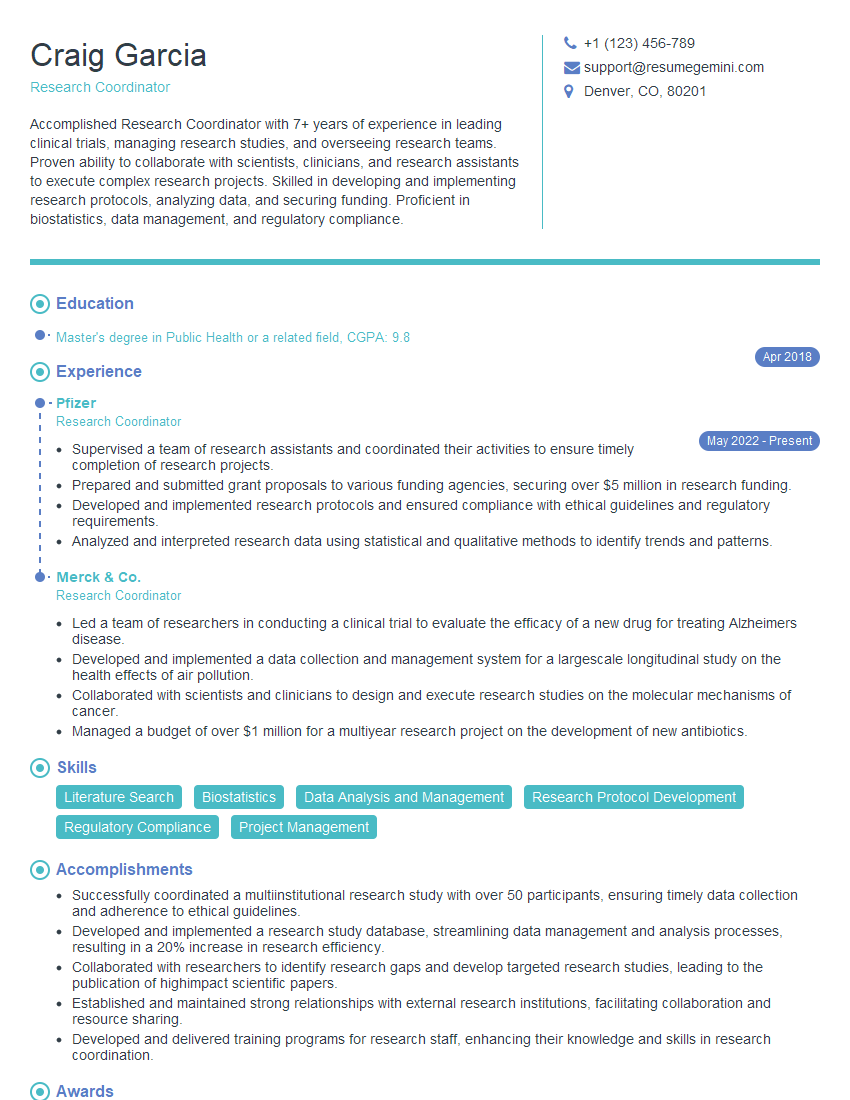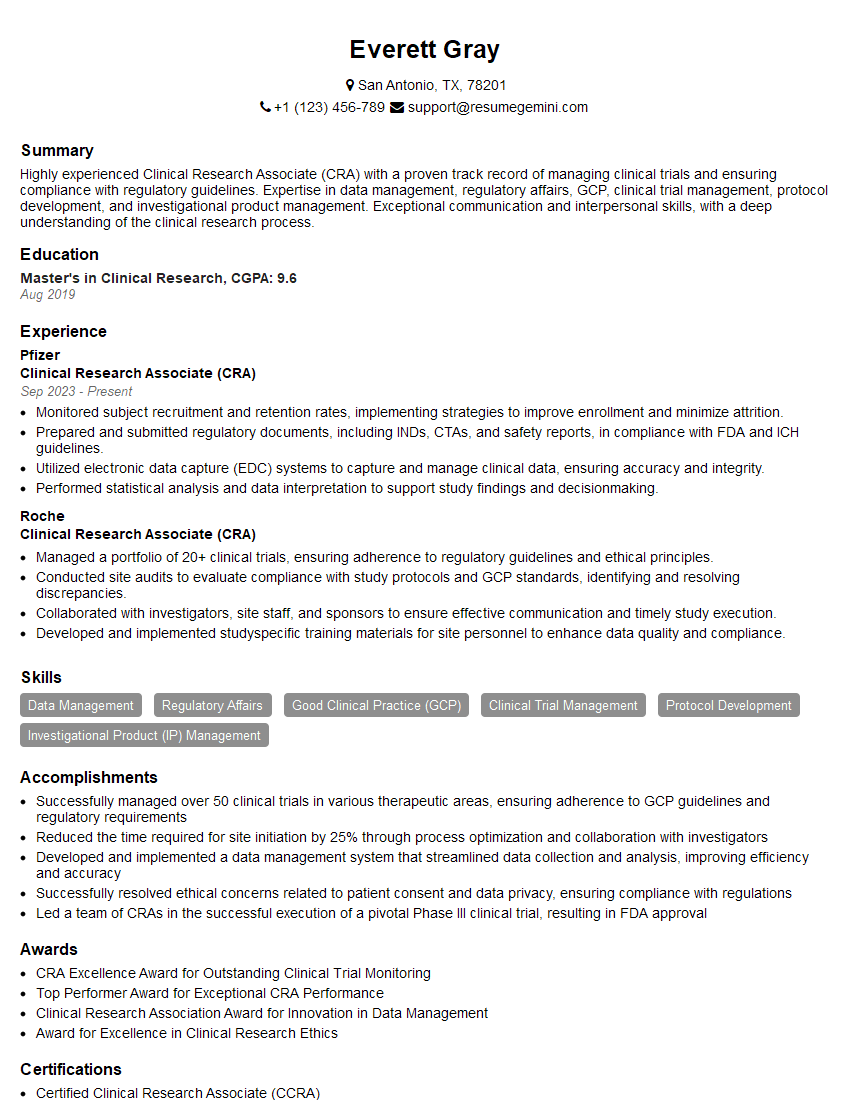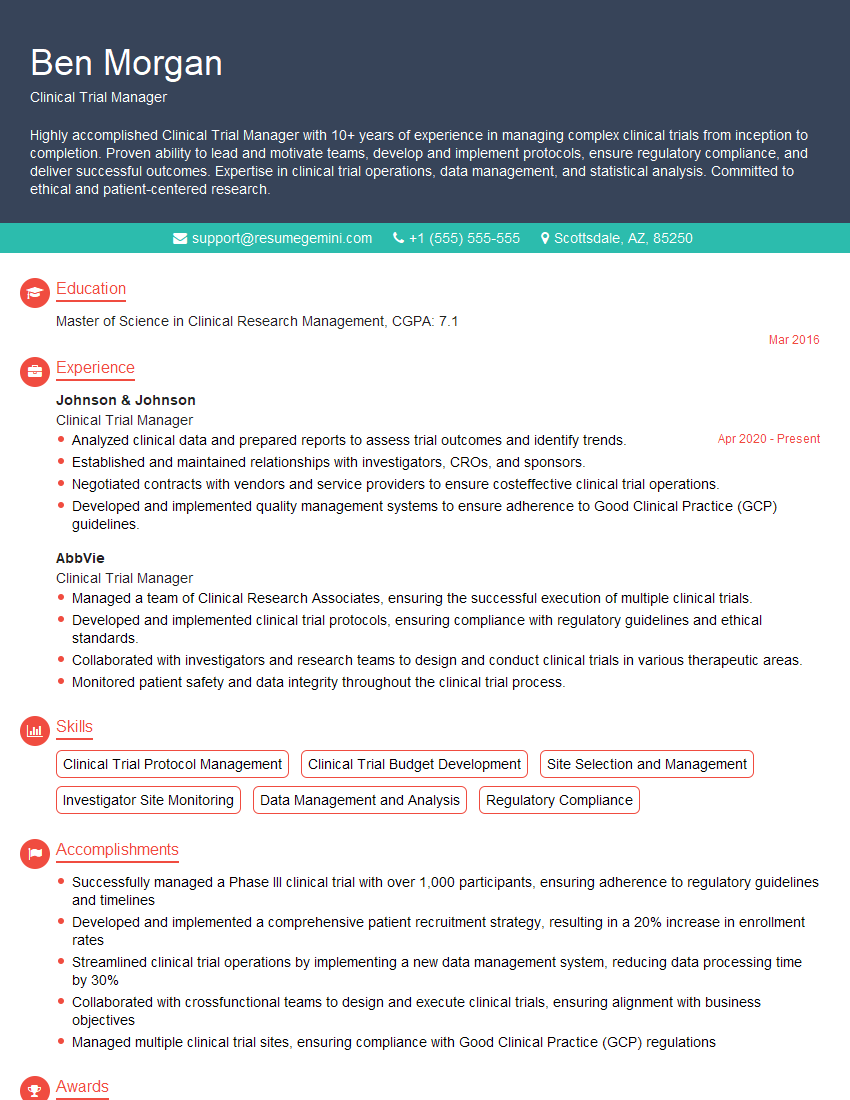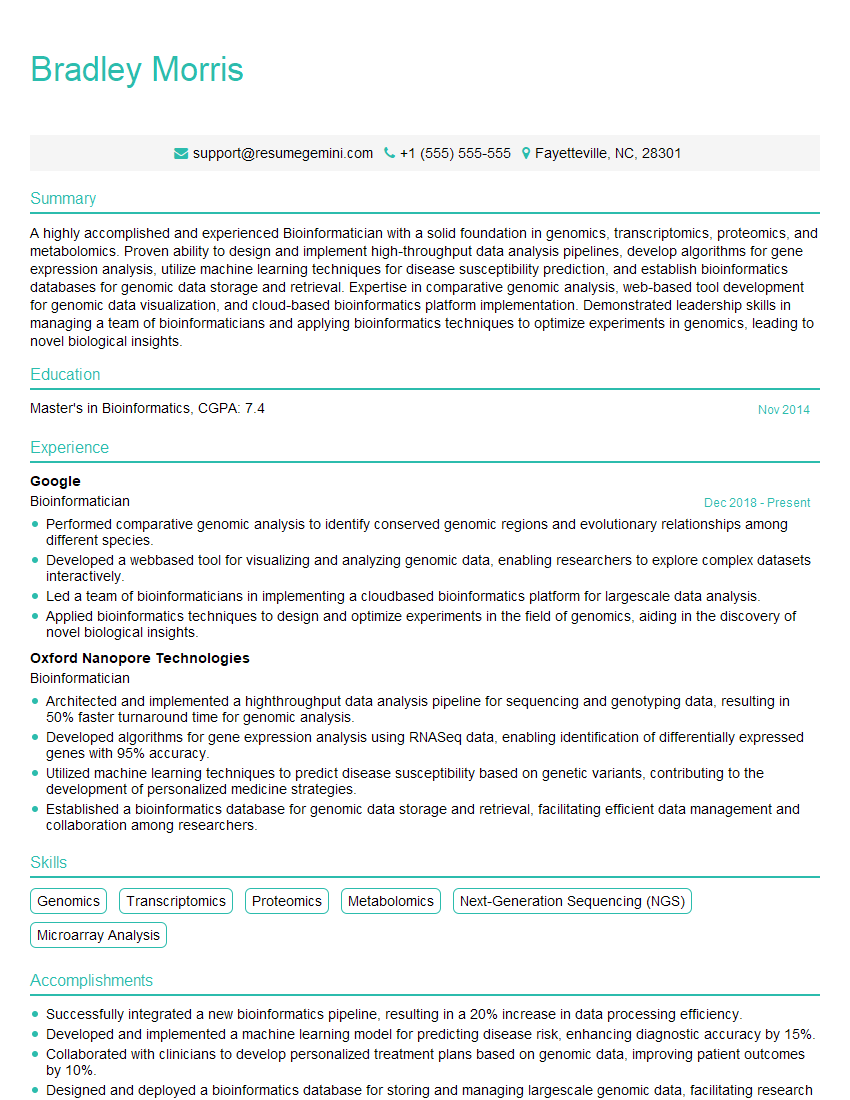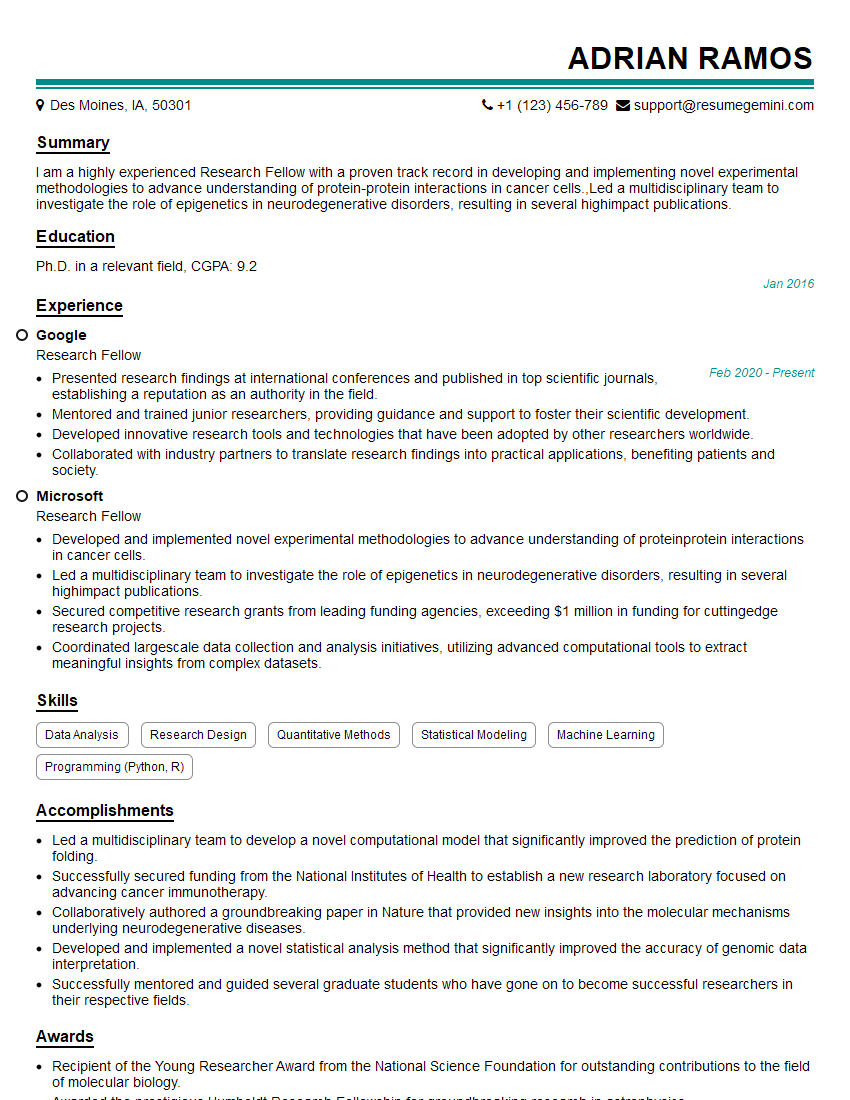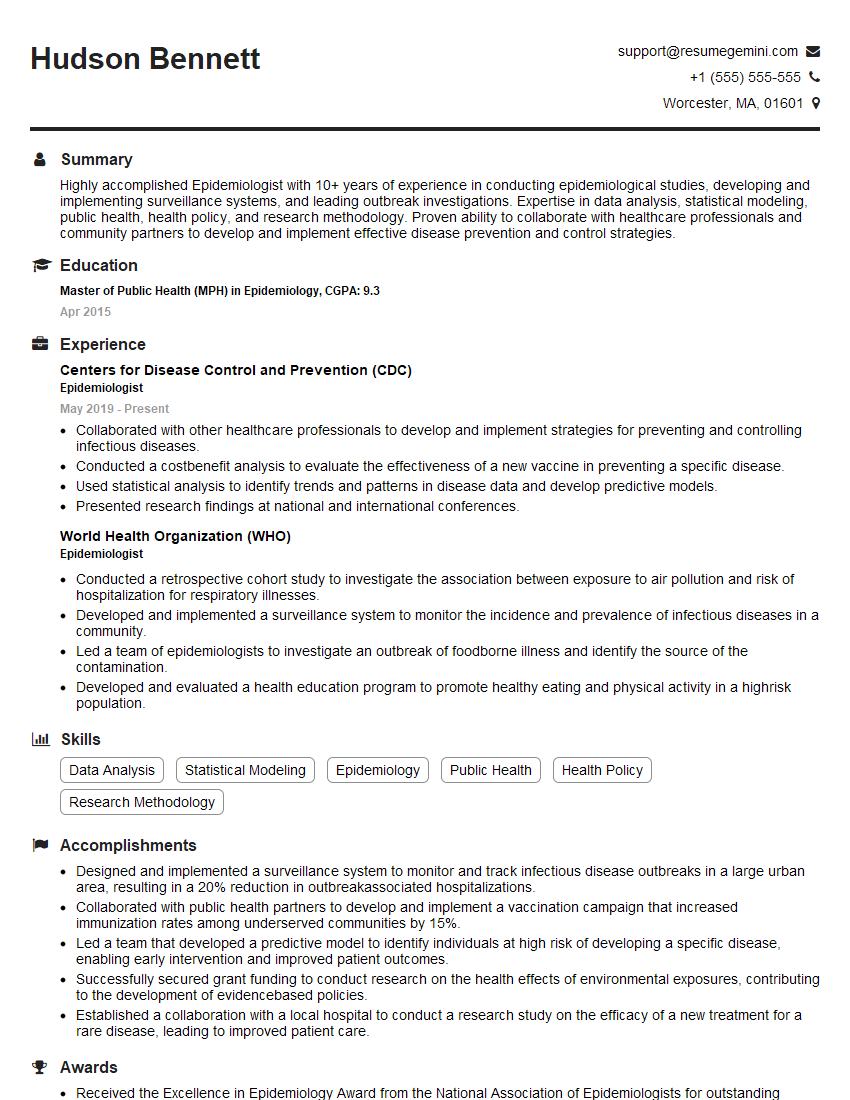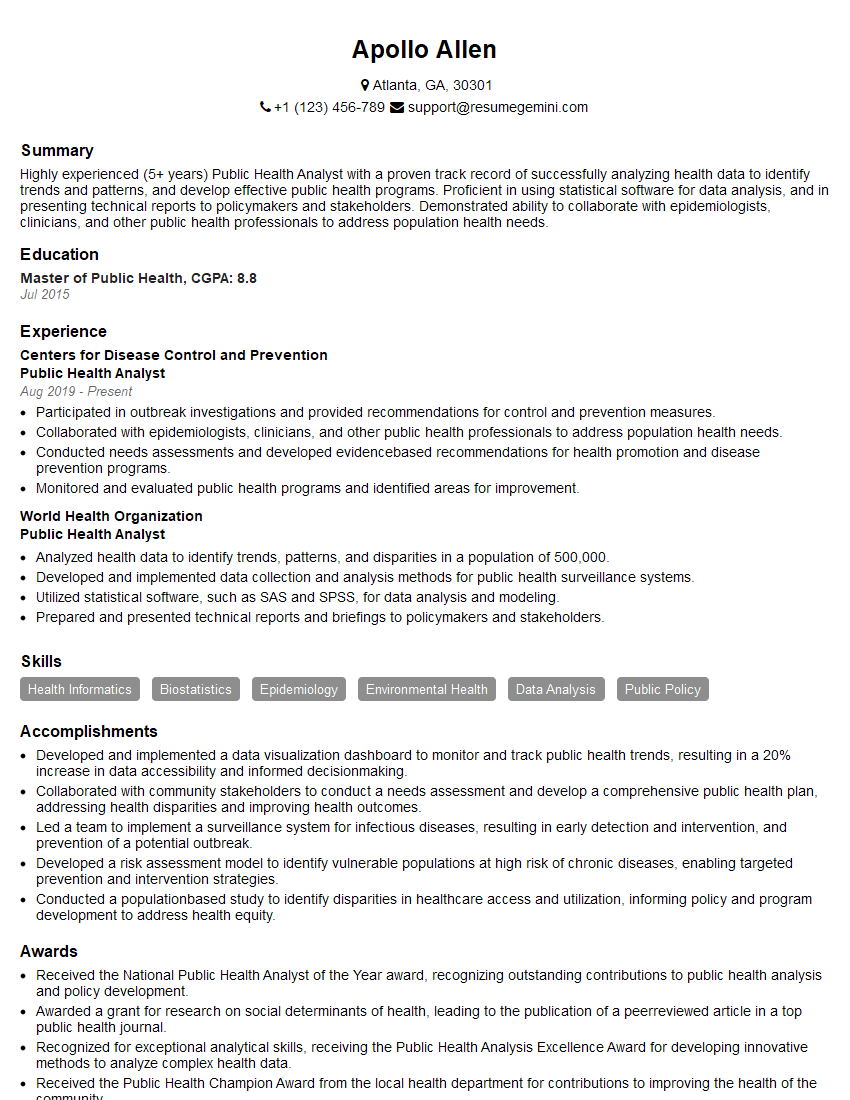Warning: search_filter(): Argument #2 ($wp_query) must be passed by reference, value given in /home/u951807797/domains/techskills.interviewgemini.com/public_html/wp-includes/class-wp-hook.php on line 324
Preparation is the key to success in any interview. In this post, we’ll explore crucial Healthcare Research Methods interview questions and equip you with strategies to craft impactful answers. Whether you’re a beginner or a pro, these tips will elevate your preparation.
Questions Asked in Healthcare Research Methods Interview
Q 1. Explain the difference between qualitative and quantitative research methods in healthcare.
Qualitative and quantitative research methods represent distinct approaches to understanding healthcare phenomena. Quantitative research focuses on numerical data and statistical analysis to establish relationships between variables. Think of it like measuring the height and weight of patients to see if there’s a correlation with a particular disease. It aims for objectivity and generalizability. Qualitative research, on the other hand, explores in-depth understanding of experiences, perspectives, and meanings. Imagine interviewing patients to understand their lived experience with a chronic illness. It prioritizes rich descriptions and nuanced interpretations.
- Quantitative: Uses surveys, experiments (like RCTs), and structured observations; analyzes data using statistical software.
- Qualitative: Uses interviews, focus groups, and ethnography; analyzes data through thematic analysis, coding, and interpretation.
In practice, these methods are often complementary. A quantitative study might reveal a correlation, prompting a qualitative study to explore the ‘why’ behind the findings. For example, a quantitative study might show a higher incidence of a disease in a specific population. A following qualitative study could then interview members of that population to uncover the underlying social, environmental, or behavioral factors contributing to this disparity.
Q 2. Describe the strengths and weaknesses of randomized controlled trials (RCTs).
Randomized controlled trials (RCTs) are considered the gold standard in evaluating the effectiveness of healthcare interventions. They involve randomly assigning participants to either an intervention group (receiving the treatment) or a control group (receiving a placebo or standard care). This randomization minimizes bias and allows researchers to attribute any observed differences between groups to the intervention.
- Strengths: RCTs provide strong evidence of causality, minimizing bias through randomization and blinding. They are highly rigorous and generally accepted as the most reliable method for evaluating interventions.
- Weaknesses: RCTs can be expensive and time-consuming. They may not always be feasible or ethical, particularly for certain interventions or populations. The highly controlled environment of an RCT may not accurately reflect real-world settings, limiting generalizability. Also, the inclusion criteria may exclude a significant portion of the population making the results less applicable to diverse groups.
For instance, an RCT might evaluate the effectiveness of a new drug for hypertension. Randomly assigning participants to either the drug or a placebo allows for a clear comparison of blood pressure changes. However, the carefully controlled environment of the trial may not fully capture how the drug would perform in a more diverse population with comorbidities or varying adherence to medication regimens.
Q 3. What are the ethical considerations in conducting healthcare research?
Ethical considerations are paramount in healthcare research. They guide researchers in protecting the rights and well-being of participants. Key ethical principles include:
- Respect for persons: Protecting autonomy (informed consent), protecting vulnerable populations (e.g., children, cognitively impaired individuals).
- Beneficence: Maximizing benefits and minimizing harms; ensuring the research design is sound and the risks are justified by the potential benefits.
- Justice: Ensuring fair selection of participants and equitable distribution of benefits and burdens; avoiding exploitation of vulnerable groups.
Before conducting any research, ethical review boards (IRBs) must approve the study protocol to ensure it meets these ethical standards. This process involves detailed review of the research plan, informed consent procedures, data management, and risk mitigation strategies. A classic example is the Tuskegee Syphilis Study, where participants were not informed of their diagnosis or given treatment, highlighting the critical importance of ethical oversight.
Q 4. How do you ensure the validity and reliability of your research findings?
Ensuring validity and reliability is crucial for the credibility of research findings. Validity refers to the accuracy of the measurements and the extent to which the research truly measures what it intends to measure. Reliability refers to the consistency and reproducibility of the results. Several strategies are used to enhance both:
- Validity: Using established and validated measures; employing appropriate research designs (e.g., RCTs for causal inference); using triangulation (combining different methods to confirm findings); member checking (having participants review findings).
- Reliability: Using standardized procedures; employing multiple raters or observers; testing for inter-rater reliability; conducting pilot studies to identify and refine methods.
For instance, in a study measuring patient satisfaction, using a validated questionnaire ensures content validity (the questionnaire actually measures aspects of satisfaction). Testing the questionnaire on a pilot group helps establish its reliability by checking for consistent results across multiple administrations. Furthermore, employing multiple raters when coding qualitative data ensures the consistency of the interpretation.
Q 5. Explain the concept of blinding in clinical trials.
Blinding, also known as masking, is a technique used in clinical trials to prevent bias by keeping participants and/or researchers unaware of the treatment assignment. This helps to ensure that the results are not influenced by the expectations of either party.
- Single-blind: Participants are unaware of their treatment assignment (e.g., receiving placebo or active drug), but the researchers are aware.
- Double-blind: Both participants and researchers are unaware of the treatment assignment. This is considered the gold standard to minimize bias.
- Triple-blind: An extension of double-blind, where even the data analysts are unaware of treatment assignment until after data analysis is complete. This is less common but provides an extra level of protection against bias.
For example, in a drug trial evaluating a new pain reliever, blinding ensures that neither the patient nor the doctor assessing the patient’s pain knows whether the patient is receiving the actual medication or a placebo. This prevents potential bias from influencing the assessment of pain reduction.
Q 6. What are the different types of sampling methods used in healthcare research?
Various sampling methods are used in healthcare research to select a representative subset of the population of interest. The choice of method depends on the research question, resources, and population characteristics.
- Probability sampling: Every member of the population has a known, non-zero probability of being selected. This includes simple random sampling, stratified random sampling (ensuring representation from different subgroups), cluster sampling (sampling groups within the population), and systematic sampling (selecting every nth individual).
- Non-probability sampling: The probability of selection is unknown. This includes convenience sampling (selecting readily available individuals), purposive sampling (selecting individuals based on specific criteria), snowball sampling (participants refer other participants), and quota sampling (ensuring representation of specific subgroups based on pre-defined proportions).
For example, a study evaluating the prevalence of diabetes in a city might use stratified random sampling to ensure representation from different age groups and socioeconomic strata. A qualitative study exploring the experiences of caregivers of Alzheimer’s patients might use purposive sampling to select participants with specific characteristics, such as length of caregiving experience or caregiver burden.
Q 7. How do you deal with missing data in a healthcare research study?
Missing data is a common challenge in healthcare research. It can lead to biased results and reduced statistical power. The approach to handling missing data depends on the pattern and extent of missingness:
- Identifying the pattern of missing data: Is it missing completely at random (MCAR), missing at random (MAR), or missing not at random (MNAR)? This influences the choice of handling strategy.
- Strategies for handling missing data: Complete case analysis (excluding participants with any missing data); imputation (replacing missing values with estimated values); multiple imputation (creating multiple plausible datasets with imputed values); weighting adjustments.
For instance, if data on medication adherence is missing more frequently in participants who had adverse effects from the medication (MNAR), then simple imputation methods may not be appropriate. More sophisticated techniques like multiple imputation or weighting adjustment would be considered. It’s crucial to carefully document the method used and acknowledge potential limitations introduced by missing data.
Q 8. Describe your experience with statistical software packages (e.g., SPSS, SAS, R).
Throughout my career, I’ve extensively used several statistical software packages, each with its strengths. SPSS, for instance, is excellent for its user-friendly interface and its robust capabilities for managing and analyzing large datasets, particularly in survey research. I’ve used it extensively for conducting descriptive statistics, t-tests, ANOVAs, and regression analyses in various healthcare studies. SAS, on the other hand, offers unparalleled power and flexibility, especially for complex procedures and custom programming. I’ve leveraged SAS’s procedural programming capabilities for creating customized data manipulation routines and advanced statistical modeling, including survival analysis and multilevel modeling. Finally, R provides a highly versatile and open-source environment. Its strength lies in its extensive libraries and community support for specialized statistical methods and data visualization. I’ve utilized R for more advanced statistical modeling, such as Bayesian statistics and machine learning techniques, increasingly important in precision medicine.
For example, in a recent study on the effectiveness of a new diabetes medication, I used SPSS to perform initial descriptive analyses and t-tests comparing treatment groups. Then, using SAS, I created a custom macro to handle missing data and conduct a more rigorous analysis using generalized estimating equations (GEE) to account for the correlated nature of the data collected over time. Furthermore, R’s flexibility allowed me to build predictive models using machine learning algorithms to identify patients most likely to benefit from the medication.
Q 9. Explain the concept of p-values and their interpretation in healthcare research.
The p-value is a probability that quantifies the evidence against a null hypothesis. In simpler terms, it tells us the likelihood of observing our data (or more extreme data) if there were truly no effect or difference between groups. A smaller p-value suggests stronger evidence against the null hypothesis.
In healthcare research, the null hypothesis often represents the absence of an effect—for example, no difference in effectiveness between two treatments or no association between a risk factor and a disease. A common threshold is p ≤ 0.05. If the p-value is below this threshold, we typically reject the null hypothesis and conclude there’s statistically significant evidence for an effect. However, it’s crucial to remember that p-values alone are insufficient. Effect size, confidence intervals, and the clinical significance of the findings should also be considered.
Consider a study comparing two blood pressure medications. A p-value of 0.03 suggests a statistically significant difference in effectiveness between the medications. This means there’s a 3% chance of observing the difference seen in the study if there was actually no difference between the medications in the larger population. However, a small difference might not be clinically meaningful if the cost or side effects of the more effective medication are significant.
Q 10. What are the key elements of a well-written research proposal?
A well-written research proposal is crucial for securing funding and conducting successful research. Key elements include:
- A clear and concise research question: This guides the entire study and should be focused, feasible, and relevant.
- A thorough literature review: This demonstrates the context and significance of the research, highlighting gaps in existing knowledge.
- A well-defined methodology: This details the study design, sample size calculation, data collection methods, and statistical analyses to be used.
- Ethical considerations: This addresses potential risks and benefits to participants, ensuring compliance with ethical guidelines and obtaining necessary approvals (e.g., IRB).
- A realistic timeline and budget: This outlines the project’s duration and the resources required.
- Expected outcomes and dissemination plan: This explains how the results will be interpreted and shared with the scientific community and stakeholders.
A strong research proposal is not just a list of components; it’s a cohesive narrative that convincingly argues for the need for the study and its potential impact.
Q 11. How do you interpret a confidence interval?
A confidence interval (CI) provides a range of values within which the true population parameter is likely to lie. For instance, a 95% CI means we are 95% confident that the true value falls within that interval. It’s not a statement about the certainty of a single value but rather about the plausibility of a range of values.
Let’s say we’re studying the average blood glucose level in patients with type 2 diabetes. We might obtain a sample mean of 150 mg/dL with a 95% CI of (140, 160) mg/dL. This means we’re 95% confident that the true average blood glucose level in the entire population of patients with type 2 diabetes lies between 140 and 160 mg/dL. A narrower CI indicates greater precision in our estimate, while a wider CI reflects greater uncertainty.
The interpretation depends heavily on context. A wide CI might indicate the need for a larger sample size to improve precision. Overlapping confidence intervals between two groups might suggest a lack of significant difference. Therefore, always consider the CI in conjunction with p-values and effect sizes for a comprehensive understanding of the results.
Q 12. Describe your experience with systematic reviews and meta-analyses.
I have significant experience conducting and leading systematic reviews and meta-analyses. Systematic reviews provide a comprehensive summary of existing evidence on a specific research question by systematically searching, appraising, and synthesizing relevant studies. Meta-analyses go a step further by statistically combining the results of multiple studies to produce a single, more precise estimate of the effect.
In my work, I’ve been involved in every stage—from developing the search strategy and selecting studies based on predetermined inclusion and exclusion criteria to assessing the quality of included studies, extracting relevant data, and performing statistical analyses using appropriate meta-analytic techniques (e.g., fixed-effects or random-effects models). I’m adept at handling heterogeneity across studies and interpreting the results within the context of existing literature. For example, I recently led a meta-analysis examining the long-term effects of a specific surgical intervention. This involved rigorous screening of studies, careful consideration of potential bias, and use of appropriate statistical techniques to pool the data, providing a more robust estimate of the treatment effect than any single study could offer on its own.
Q 13. What is the difference between descriptive and inferential statistics?
Descriptive and inferential statistics serve different purposes in data analysis.
- Descriptive statistics summarize and describe the main features of a dataset. They don’t make inferences about a larger population. Common examples include measures of central tendency (mean, median, mode), measures of variability (standard deviation, range), and frequencies.
- Inferential statistics go beyond summarizing data; they involve drawing conclusions about a population based on a sample. These techniques help us test hypotheses, make predictions, and generalize findings from a sample to a larger group. Examples include t-tests, ANOVAs, chi-square tests, and regression analysis.
Think of it this way: descriptive statistics are like taking a snapshot of your data, while inferential statistics are like using that snapshot to make educated guesses about a larger landscape. In a clinical trial, descriptive statistics might show the average blood pressure in each treatment group, while inferential statistics would determine if there’s a statistically significant difference between the groups.
Q 14. Explain the process of developing a research question.
Developing a strong research question is paramount for any successful research project. The process usually involves several iterative steps:
- Identify a broad area of interest: Start by focusing on a general area within healthcare that interests you and where research is needed.
- Review the existing literature: Conduct a thorough literature review to understand current knowledge, identify gaps, and pinpoint unanswered questions.
- Refine the research question: Based on the literature review, narrow down your area of focus and formulate a specific, researchable question. This often involves formulating a hypothesis, a testable statement about the relationship between variables.
- Consider feasibility: Assess the practicality of answering your research question given available resources, time, and ethical considerations.
- Refine and finalize: Continuously refine your question, ensuring it is clear, concise, and directly addresses the research gap you identified. This often involves discussions with colleagues and mentors.
For instance, a broad interest in diabetes might lead to a literature review focusing on the effectiveness of different treatment strategies. This review might reveal limited data on a specific new treatment, leading to a focused research question like: “Does the new drug X reduce HbA1c levels more effectively than the current standard of care in patients with type 2 diabetes?”
Q 15. How do you manage the risks and challenges associated with conducting research?
Risk management in healthcare research is paramount. It involves proactively identifying, assessing, and mitigating potential issues that could compromise the study’s integrity, validity, or the well-being of participants. This is a multifaceted process.
Ethical Considerations: This includes obtaining informed consent, ensuring participant safety and confidentiality, and adhering to ethical guidelines like those set by Institutional Review Boards (IRBs). For example, a study involving a new drug must have robust safety monitoring protocols in place to detect and manage adverse events.
Data Integrity: Maintaining data accuracy and reliability is crucial. We use techniques like data validation, double data entry, and regular audits to prevent errors and ensure data quality. For example, if there’s a discrepancy between the collected data and the expected data range, we would thoroughly investigate the source of the error.
Financial Risks: Securing adequate funding and managing resources effectively are essential to avoid delays and budget overruns. We carefully plan the budget, track expenditures, and seek additional funding if necessary.
Recruitment and Retention: Difficulty in recruiting participants or high attrition rates can significantly impact study results. We address this by developing effective recruitment strategies, providing incentives, maintaining communication with participants, and addressing potential barriers to participation. A clear communication plan reduces participant burden and improves retention.
Regulatory Compliance: Researchers must adhere to all relevant regulations and guidelines. This includes obtaining necessary approvals from regulatory bodies, maintaining accurate records, and reporting any adverse events promptly. Failure to comply could lead to serious consequences.
A risk management plan, regularly reviewed and updated, is essential. It helps proactively address potential problems and keeps the research on track.
Career Expert Tips:
- Ace those interviews! Prepare effectively by reviewing the Top 50 Most Common Interview Questions on ResumeGemini.
- Navigate your job search with confidence! Explore a wide range of Career Tips on ResumeGemini. Learn about common challenges and recommendations to overcome them.
- Craft the perfect resume! Master the Art of Resume Writing with ResumeGemini’s guide. Showcase your unique qualifications and achievements effectively.
- Don’t miss out on holiday savings! Build your dream resume with ResumeGemini’s ATS optimized templates.
Q 16. Describe your experience with data visualization techniques.
Data visualization is critical for effectively communicating research findings. My experience encompasses a range of techniques, including:
Descriptive statistics: Using tables, bar charts, and histograms to summarize key features of the data. For example, visualizing the distribution of age or disease severity among participants.
Inferential statistics: Employing box plots, scatter plots, and line graphs to illustrate relationships between variables and the results of statistical tests. For instance, a scatter plot can show the correlation between blood pressure and age.
Interactive dashboards: Using tools like Tableau or Power BI to create interactive visualizations that allow for exploring data in various ways. This is particularly useful for presenting complex datasets.
Geographic Information Systems (GIS): When relevant, utilizing GIS to map the geographic distribution of diseases or health outcomes. This helps identify spatial patterns and inform targeted interventions.
Beyond the technical skills, I also emphasize clear labeling, appropriate scales, and effective legends to ensure the visualizations are easily understood by diverse audiences, including non-experts. I often use storytelling techniques to integrate the visualizations into a compelling narrative that strengthens the message.
Q 17. What are some common biases in healthcare research, and how can they be mitigated?
Many biases can affect healthcare research. Addressing them is essential to obtain accurate and reliable results.
Selection bias: This arises when the study sample is not representative of the target population. For instance, a study recruiting participants only from a specific hospital might not generalize to the broader population. Randomization and stratified sampling help mitigate this.
Information bias: This occurs when there are inaccuracies or inconsistencies in the data collected. For example, recall bias might happen when participants are asked to remember past events, leading to inaccurate reporting. Standardized data collection tools and blinding techniques can help reduce this bias.
Confirmation bias: The researcher’s preconceived notions can influence data interpretation. To combat this, researchers should adhere to pre-defined analysis plans and use objective criteria for evaluating results. Independent review by others helps.
Publication bias: Studies with positive results are more likely to be published than those with negative or null findings. This can create a skewed view of the evidence. Systematic reviews and meta-analyses aim to address this by including both positive and negative studies.
Employing rigorous study design, appropriate statistical methods, and transparent reporting practices are crucial for minimizing biases. Peer review also plays a vital role in identifying and addressing potential biases before publication.
Q 18. Explain the principles of good clinical practice (GCP).
Good Clinical Practice (GCP) is an international ethical and scientific quality standard for designing, conducting, recording, and reporting clinical research involving human participants. It ensures the rights, safety, and well-being of trial participants are protected, and that the clinical trial data are credible and reliable.
Ethical Considerations: GCP emphasizes ethical principles, including informed consent, confidentiality, and minimizing risks to participants. This ensures research aligns with ethical guidelines and regulations.
Data Integrity: GCP mandates accurate, complete, and verifiable data recording and handling. This ensures the quality and integrity of the study’s findings.
Regulatory Compliance: Researchers must follow all applicable regulatory requirements, including those related to Institutional Review Boards (IRBs), Good Manufacturing Practice (GMP), and relevant national and international regulations.
Protocol Adherence: GCP emphasizes strict adherence to the study protocol. This ensures consistency in the research process and prevents deviations that could compromise the results.
Quality Assurance: GCP incorporates quality assurance measures, including monitoring and auditing, to ensure that the research is conducted to the highest standards. This maintains data credibility and addresses any issues promptly.
Adhering to GCP is not merely a regulatory requirement; it is a fundamental commitment to ethical research practices and the generation of trustworthy evidence.
Q 19. How do you ensure the confidentiality and anonymity of participants in your research?
Confidentiality and anonymity are crucial in protecting research participants. We use several methods to safeguard their data:
Data anonymization: Removing identifying information from the data, such as names, addresses, and medical record numbers, to prevent linking the data back to individuals.
Data encryption: Protecting data using encryption methods to prevent unauthorized access and use of sensitive information. This is particularly crucial for electronic data storage.
Secure data storage: Storing data on secure servers with limited access and robust security measures to prevent unauthorized access or breaches.
Informed consent: Obtaining informed consent from participants explicitly outlining how their data will be handled and protected. This transparent process is key to building trust.
Data access control: Limiting access to the data to only authorized personnel who need it for research purposes.
De-identification: Employing advanced techniques such as de-identification to create a data set which cannot be linked to the original participants.
We also adhere to all relevant data privacy regulations, such as HIPAA in the United States, to ensure compliance and maintain participant trust.
Q 20. Describe your experience with different types of research designs (e.g., cohort studies, case-control studies).
My experience encompasses various research designs, each with its strengths and limitations.
Cohort studies: These follow a group of individuals over time to observe the incidence of a specific outcome. For example, following a cohort of smokers to observe the development of lung cancer. This allows us to assess risk factors and causal relationships, but they can be time-consuming and expensive.
Case-control studies: These compare individuals with a particular outcome (cases) to those without the outcome (controls) to identify potential risk factors. For example, comparing people with heart disease to people without heart disease to identify risk factors. This design is relatively efficient and cost-effective, but it’s prone to recall bias and may not establish causality.
Randomized controlled trials (RCTs): These are considered the gold standard for evaluating the effectiveness of interventions. Participants are randomly assigned to either an intervention group or a control group, allowing us to make causal inferences. For example, an RCT comparing a new drug to a placebo for treating hypertension. RCTs are rigorous but can be challenging to conduct and may not always be feasible or ethical.
Cross-sectional studies: These examine the prevalence of a particular outcome at a single point in time. For example, a survey to assess the prevalence of diabetes in a particular population. This is relatively quick and easy to conduct, but it cannot establish temporal relationships.
The choice of research design depends heavily on the research question, available resources, and ethical considerations. A well-chosen design is crucial to the validity and reliability of the research findings.
Q 21. Explain the importance of peer review in healthcare research.
Peer review is a cornerstone of quality assurance in healthcare research. It’s a process where experts in the field critically evaluate a research manuscript before it is published.
Ensuring Rigor: Peer reviewers assess the study’s methodology, data analysis, and interpretation for flaws, biases, and inconsistencies. This ensures the research meets high scientific standards.
Improving Quality: Reviewers’ feedback helps authors refine their work, improving clarity, accuracy, and completeness. This strengthens the overall quality of the publication.
Maintaining Credibility: The peer-review process helps maintain the credibility of published research. It filters out flawed or unreliable studies, promoting trust in the scientific literature.
Identifying Bias: Peer review can identify potential biases in the study design, data collection, or interpretation, ensuring a more objective evaluation of the findings.
Advancing Scientific Knowledge: By subjecting research to rigorous scrutiny, peer review contributes to the advancement of scientific knowledge. It helps ensure that only high-quality, reliable research is disseminated to the wider scientific community.
While not foolproof, peer review is a crucial safeguard against the publication of flawed research and a key element in maintaining the integrity of the scientific literature. It promotes transparency and accountability within the research community.
Q 22. How do you interpret and apply regression analysis in healthcare?
Regression analysis is a powerful statistical method used to model the relationship between a dependent variable and one or more independent variables in healthcare research. Imagine you’re studying the effect of blood pressure (independent variable) on the risk of heart attack (dependent variable). Regression analysis helps us quantify this relationship, determining how much the risk of heart attack changes for every unit increase in blood pressure. We can use this to predict the risk for individuals with specific blood pressure levels.
In healthcare, we often use several types of regression: linear regression for continuous dependent variables (e.g., blood pressure), logistic regression for binary outcomes (e.g., heart attack – yes/no), and Poisson regression for count data (e.g., number of hospital readmissions). The choice depends on the nature of the data.
For example, if we find a positive coefficient in a linear regression model linking blood pressure to heart attack risk, it indicates that higher blood pressure is associated with a higher risk. The magnitude of the coefficient reflects the strength of the association. Interpreting regression output requires careful consideration of p-values (statistical significance) and R-squared (proportion of variance explained).
Applying regression in healthcare involves careful data preparation, model selection (including variable selection to avoid overfitting), and interpretation of the results within the clinical context. It’s crucial to remember that correlation doesn’t equal causation; regression analysis helps identify associations, not necessarily causal relationships. Further investigation, potentially using randomized controlled trials, might be necessary to establish causality.
Q 23. What are the key considerations for selecting an appropriate statistical test?
Selecting the appropriate statistical test is crucial for accurate and reliable research findings. The choice depends on several key factors:
- Type of data: Is your data continuous (e.g., weight, blood pressure), categorical (e.g., gender, treatment group), or ordinal (e.g., pain scale)?
- Number of groups: Are you comparing two groups or more than two?
- Research question: Are you looking for differences between groups (e.g., t-test, ANOVA), associations between variables (e.g., correlation, regression), or predicting an outcome (e.g., regression)?
- Data distribution: Is your data normally distributed? If not, non-parametric tests might be more appropriate.
- Sample size: The sample size influences the power of the test.
For instance, if you’re comparing the average blood pressure between a treatment and control group, and your data is normally distributed, an independent samples t-test would be suitable. If the data is not normally distributed, a Mann-Whitney U test (a non-parametric alternative) would be a better choice. If you have more than two groups, an ANOVA (analysis of variance) would be more appropriate, followed by post-hoc tests if significance is found.
Choosing the wrong statistical test can lead to inaccurate conclusions. It’s vital to consult with a statistician or carefully review statistical guidelines to ensure the appropriate test is used.
Q 24. Describe your experience with data management and cleaning.
My experience with data management and cleaning is extensive. It’s a crucial step that often takes more time than the analysis itself. I’m proficient in using software like R and SAS to manage and clean large healthcare datasets. This involves several steps:
- Data import and organization: This includes importing data from various sources, ensuring consistent formatting, and creating a well-structured dataset.
- Data validation: Checking for inconsistencies, errors, and missing values. This often involves creating descriptive statistics and identifying outliers.
- Data cleaning: Handling missing data (e.g., imputation or exclusion), transforming variables (e.g., creating dummy variables for categorical data), and dealing with outliers (e.g., winsorizing or transforming).
- Data transformation: Sometimes data needs to be transformed (e.g., log transformation) to meet the assumptions of certain statistical tests.
- Data documentation: Creating a comprehensive codebook documenting variables, data types, and cleaning steps.
For example, in a study on diabetes, I once encountered inconsistencies in the units of measurement for blood glucose levels. Careful review and cleaning were necessary to ensure accurate analysis. I also have experience working with large datasets containing sensitive patient information, and I am fully compliant with all relevant data privacy regulations.
Q 25. How familiar are you with different types of healthcare databases?
I’m familiar with a wide range of healthcare databases, including:
- Electronic Health Records (EHRs): Such as Epic, Cerner, and Allscripts. These contain detailed patient information, including demographics, diagnoses, medications, and lab results.
- Claims databases: These contain information on healthcare utilization and costs, often used for population health studies. Examples include Medicare and Medicaid claims data.
- Clinical trial databases: These are specifically designed for managing and analyzing data from clinical trials.
- Registries: These databases collect information on specific diseases or conditions, facilitating large-scale epidemiological studies.
- Biobanks: These store biological samples (e.g., blood, tissue) linked to clinical data, enabling genomic and other molecular studies.
My experience includes working with structured data from EHRs and unstructured data from clinical notes, requiring different data extraction and processing techniques. I understand the complexities of working with these various data sources, including data security and privacy issues.
Q 26. Explain the concept of effect size and its importance.
Effect size quantifies the magnitude of an effect or relationship between variables. It’s a crucial measure that complements statistical significance (p-values). A statistically significant result might have a small effect size, indicating limited practical importance. Imagine two drugs treating high blood pressure; one lowers it by 1 mmHg and the other by 10 mmHg. The first may be statistically significant but clinically insignificant compared to the second.
There are different ways to calculate effect size, depending on the type of statistical test. Common effect size measures include:
- Cohen’s d: For comparing means between two groups.
- Eta-squared (η²): For ANOVA, representing the proportion of variance explained by the independent variable.
- Odds ratio (OR) and relative risk (RR): For comparing the incidence of an outcome between two groups.
The importance of effect size lies in its ability to provide a more comprehensive understanding of the practical significance of research findings. A large effect size indicates a substantial impact, regardless of the sample size, making the finding more meaningful in real-world applications. Reporting both p-values and effect sizes is essential for a complete interpretation of research results.
Q 27. How do you present and communicate your research findings effectively?
Effective communication of research findings is critical to ensure that the results are understood and utilized. My approach involves tailoring the presentation to the audience and using a variety of methods:
- Clear and concise writing: I use plain language, avoiding jargon whenever possible, and focus on conveying the key findings clearly.
- Visual aids: Graphs, charts, and tables are essential for presenting complex data in an easily digestible format. I use these strategically to highlight key findings and trends.
- Oral presentations: I’m comfortable presenting findings to diverse audiences, adjusting my communication style to suit their level of expertise.
- Written reports: I prepare detailed reports that follow a standard format, including an abstract, introduction, methods, results, discussion, and conclusion.
- Collaboration: I actively collaborate with clinicians and other stakeholders to ensure that research results are relevant and actionable.
For example, when presenting findings on a new diagnostic test, I wouldn’t focus on complex statistical models, instead emphasizing the test’s accuracy, ease of use, and potential impact on patient care. I aim for my communication to be both informative and engaging, encouraging discussion and collaboration.
Q 28. How do you stay up-to-date with the latest advancements in healthcare research methods?
Staying up-to-date in the rapidly evolving field of healthcare research methods is crucial. I employ several strategies:
- Regularly reading peer-reviewed journals: I subscribe to leading journals in biostatistics, epidemiology, and clinical research.
- Attending conferences and workshops: This provides opportunities to learn about cutting-edge methods and network with other researchers.
- Participating in online courses and webinars: Many reputable organizations offer online training on statistical software and advanced research methods.
- Following influential researchers and organizations on social media: This keeps me informed about latest developments and publications.
- Maintaining a professional network: Collaboration with colleagues and mentors allows me to discuss new ideas and learn from their expertise.
I also actively seek out opportunities to apply new methods in my own research, continuously challenging myself to improve my skills and knowledge. This commitment to continuous learning allows me to remain at the forefront of healthcare research methodology.
Key Topics to Learn for Healthcare Research Methods Interview
- Study Design & Methodology: Understanding various research designs (e.g., randomized controlled trials, cohort studies, case-control studies), their strengths, weaknesses, and appropriate applications in healthcare settings. Consider the ethical implications of each design.
- Data Collection & Management: Mastering techniques for collecting reliable and valid data, including surveys, interviews, medical record reviews, and administrative data. Familiarize yourself with data cleaning, management, and analysis software.
- Statistical Analysis & Interpretation: Proficiency in descriptive and inferential statistics relevant to healthcare research. This includes understanding p-values, confidence intervals, effect sizes, and the appropriate use of statistical tests. Be prepared to discuss limitations of statistical methods.
- Qualitative Research Methods: Understanding approaches like thematic analysis, grounded theory, and ethnography, and their application to exploring patient experiences, healthcare provider perspectives, and health systems. Be able to compare and contrast qualitative and quantitative approaches.
- Bias & Validity: Critically evaluating research for potential sources of bias (selection bias, measurement bias, confounding) and understanding strategies for minimizing bias and ensuring the validity and reliability of research findings.
- Ethical Considerations in Healthcare Research: Deep understanding of ethical principles (beneficence, non-maleficence, autonomy, justice) and their application in the design, conduct, and reporting of healthcare research. Familiarity with IRB processes is crucial.
- Systematic Reviews & Meta-analysis: Understanding how to conduct systematic reviews and meta-analyses to synthesize existing research evidence and inform healthcare practice and policy. Be prepared to discuss the strengths and limitations of these approaches.
- Health Economics & Outcomes Research: Understanding concepts like cost-effectiveness analysis, quality-adjusted life years (QALYs), and other methods for evaluating the economic and clinical impact of healthcare interventions.
Next Steps
Mastering Healthcare Research Methods is crucial for advancing your career in this dynamic field. A strong understanding of these methods will open doors to exciting opportunities and allow you to contribute meaningfully to improving healthcare outcomes. To maximize your job prospects, create an ATS-friendly resume that effectively showcases your skills and experience. ResumeGemini is a trusted resource to help you build a professional and impactful resume that will get noticed. Examples of resumes tailored to Healthcare Research Methods are available to help you get started.
Explore more articles
Users Rating of Our Blogs
Share Your Experience
We value your feedback! Please rate our content and share your thoughts (optional).
What Readers Say About Our Blog
Hi, I represent a social media marketing agency that creates 15 engaging posts per month for businesses like yours. Our clients typically see a 40-60% increase in followers and engagement for just $199/month. Would you be interested?”
Hi, I represent an SEO company that specialises in getting you AI citations and higher rankings on Google. I’d like to offer you a 100% free SEO audit for your website. Would you be interested?
